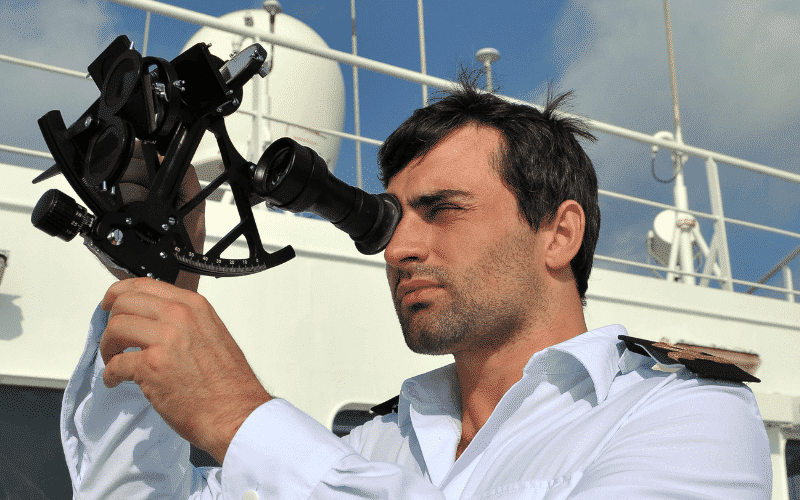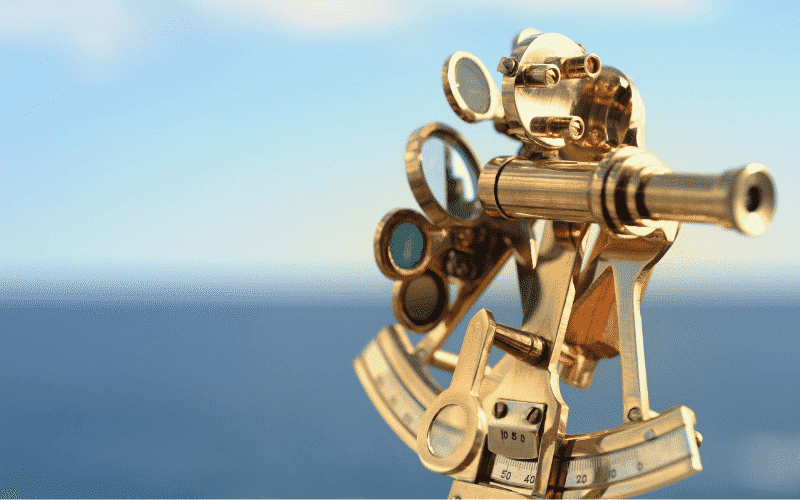

The sextant is a valuable instrument used to determine the angle between the horizon and a celestial body like the Sun, Moon or Star. It is used in celestial navigation to find out the latitude and longitude.
Sextant derives its name from the Latin word’ sextus; or ‘one-sixth’, as the sextant’s arc spans 60° or one-sixth of a circle. Octans with 45° arcs were initially used to determine the latitude. However, Sextants were developed with wider arcs to calculate longitude from lunar observations. They replaced octants by the latter half of the 18th century.
It consists of an arc of a circle marked in degrees. It also has a movable radial arm pivoted at the circle’s centre. There is a telescope mounted to the framework, which is lined with the horizon.
A mirror is placed on the radial arm. It is moved or adjusted until the celestial body is reflected into a half-silvered mirror in line with the telescope and appears to coincide with the horizon through the telescope.
The angular distance of the celestial body or star above the horizon is read from the graduated arc of the sextant.
Mainly used at sea, the tool is so named because its arc is one-sixth of a circle – 60 degrees. It adheres to the principle of double reflection hence it can measure angles up to 120 degrees. Practically speaking, the arc of the sextant is a little over 60 degrees, and therefore the total angle measurable is about 130 degrees.
Sextant is an essential tool for celestial navigation and is also used by mariners to measure the angle between the horizon and a visible object (or two objects at sea).
Hold the sextant vertically and point it in the direction of the celestial body. See the horizon through an unsilvered part of the horizon mirror. Continue to move or adjust the index arm until the image of the star/sun, which has been reflected by the index mirror and then by the silvered portion of the horizon mirror, seems to rest on the horizon.
The altitude of the celestial body can be determined by reading from the scale on the arc of the sextant’s frame.
The sextant is used to measure the following:


A ship’s altitude above the horizon was related directly to the ship’s latitude. Mariners began to invent tools for measuring these factors to aid in navigation. One of the simplest was the kamal used by Arab navigators from the 6th century onwards.
A 2-inch long rectangle board was used. A string with evenly spaced knots was attached to it. This arrangement was called a kamal. The navigator held the string using his teeth and moved this board farther from his body, aligning its bottom edge with the horizon and the top with the object, generally the Polaris or the north star.
The number of knots between the mouth and the board gave an idea of the relative height. Although kamal was quite useful, it was not precise enough and, by the 13th century, gave way to the astrolabe and the mariner’s Quadrant.
The Quadrant was popular with Portuguese explorers that travelled south along the African coast to search for a route to the Orient.
When the seafarers reached close to the equator heading south, Polaris disappeared below the horizon. Hence, in the southern seas, mariners used another way to find their latitude. Per instructions from Prince Henry of Portugal, by 1480, Portuguese astronomers had found a way to determine the latitude using the position of the Sun when it moved north and south of the equator with changing seasons, what we now refer to as its declination.
To put it simply, the navigator could calculate the Altura or altitude and latitude by using his Quadrant to take the altitude of the Sun when it came to its highest altitude at local noon and then make a correction for the position of the sun north or south of the equator per the date.
Columbus used it extensively on his voyages to the New World. He marked off the latitudes of places he visited, such as Lisbon, Serra Leoa, Cabo Verde and other places he might have landed.
Also, it was common for navigators during those times to record the altitude of the Polaris in degrees at ports where they wished to return again. Hence, lists of alturas of many ports were published to guide the seafarers up and down the coasts of Africa and Europe.
A sextant is shaped in the form of a sector (60 degrees or 1/6th of a circle). It is the reason the navigational instrument is called a Sextant (the Latin word for 1/6th is Sextans). The sector-shaped part is called the frame.
A horizontal mirror is attached to the frame, along with the index mirror, shade glasses (sunshades), telescope, graduated scale and a micrometre drum gauge.
Watch this video to understand how to use a sextant.
The normal graduations of the arc, to the left of zero, extending from 0 to 130 degrees, are referred to as ON the arc. To the right of 0 degrees, the graduations extend for a few degrees and are referred to as OFF the arc. When reading OFF the arc, graduations of the micrometer should be read in the reverse direction (59 as 1′, 55 as 1′ and so on).
The errors can be classified as
1. Adjustable Errors (adjustable onboard), and
2. Non-adjustable Errors (not adjustable onboard)


This is the angle at the observer between the plane of the observer’s sensible horizon and the direction of his visible horizon. A dip occurs because the observer is not at sea level. The value of the dip increases as the height of the eye of the observer increases. The values of dip are given on the cover page of the nautical almanac and in nautical tables (Nories) as a function of the height of the eye.
The sextant is an expensive, precision instrument which should be handled with utmost care.
Bestseller No. 1
Bestseller No. 2
Bestseller No. 3
Reference: Principles of Navigation by Capt. Joseph & Capt. Rewari, The Marine Sextant by Capt. H. Subramaniam
You may also like to read – An Introduction to Fluxgate Compass
Disclaimer: The authors’ views expressed in this article do not necessarily reflect the views of The Marine Learners. Data and charts, if used, in the article have been sourced from available information and have not been authenticated by any statutory authority. The author and The Marine Learners do not claim it to be accurate nor accept any responsibility for the same. The views constitute only the opinions and do not constitute any guidelines or recommendations on any course of action to be followed by the reader.
The article or images cannot be reproduced, copied, shared or used in any form without the permission of the author and The Marine Learners.










We believe that knowledge is power, and we’re committed to empowering our readers with the information and resources they need to succeed in the merchant navy industry.
Whether you’re looking for advice on career planning, news and analysis, or just want to connect with other aspiring merchant navy applicants, The Marine Learners is the place to be.